Last updated on October 23rd, 2023 at 08:55 pm
Birds with red head is extremely distinctive. Some species that are native to our country and have reddish markings on their heads are presented here.
There are several bird species with red heads or prominent red plumage on their heads. Here are some birds known for their red heads:
- Northern Cardinal (Cardinalis cardinalis): Male Northern Cardinals are known for their striking red plumage, including a red crest on their head. The females, on the other hand, have a more subdued coloration.
- House Finch (Haemorhous mexicanus): Male House Finches often have bright red plumage on their heads, throats, and chests. The intensity of the red color can vary.
- Red-headed Woodpecker (Melanerpes erythrocephalus): As the name suggests, these woodpeckers have entirely red heads, making them easily identifiable.
- Red-bellied Woodpecker (Melanerpes carolinus): While the Red-bellied Woodpecker’s head is not entirely red, it has a prominent red cap on its head, with a reddish wash on its belly.
- Pileated Woodpecker (Dryocopus pileatus): The Pileated Woodpecker is one of the largest woodpeckers, and it features a striking red crest on its head.
- Red-crested Pochard (Netta rufina): This diving duck has a bright red head with a distinctive red crest, making it stand out among waterfowl.
- Red-faced Cormorant (Phalacrocorax urile): These marine birds have bright red facial skin, giving them their characteristic “red face.”
- Scarlet Macaw (Ara macao): Scarlet Macaws are large, colorful parrots with brilliant red plumage on their head, wings, and tail.
- Red-crowned Crane (Grus japonensis): The Red-crowned Crane has a red patch on its crown, which stands out against its otherwise white plumage.
- Vermilion Flycatcher (Pyrocephalus rubinus): This small bird has a bright red crown and throat, making it easily recognizable.
These are just a few examples of birds with red heads or prominent red markings on their heads. Bird plumage can vary in color and intensity, and it often plays a role in their mating displays and overall appearance.
- the head is rarely completely red
- often the males have a red head and are more conspicuous than the inconspicuous females
- almost all native woodpecker species have red features on their heads
- they are not always red feathers
- sometimes they are red skin flaps (so called roses)
Contents
- 1 Rock Ptarmigan (Lagopus muta)
- 2 Bee-eater (Merops apiaster)
- 3 Common Redpoll (Carduelis flammea)
- 4 Black Grouse (Tetrao tetrix)
- 5 Blood Linnet (Carduelis cannabina)
- 6 Pheasant (Phasianus colchicus)
- 7 Spruce Crossbill (Loxia curvirostra)
- 8 Crimson Finch (Carpodacus erythrinus)
- 9 Barn Swallow (Hirundo rustica)Family: Swallows
- 10 Robin (Erithacus rubecula)Family: Thrushes
- 11 Woodchat Shrike (Lanius senator)Family: Shrikes
- 12 Waxwing (Bombycilla garrulus)Family: Waxwings
- 13 Family woodpeckers (Picidae)
- 14 Goldfinch (Carduelis carduelis)Family: Finches
- 15 Author
Rock Ptarmigan (Lagopus muta)
Family: Grouse
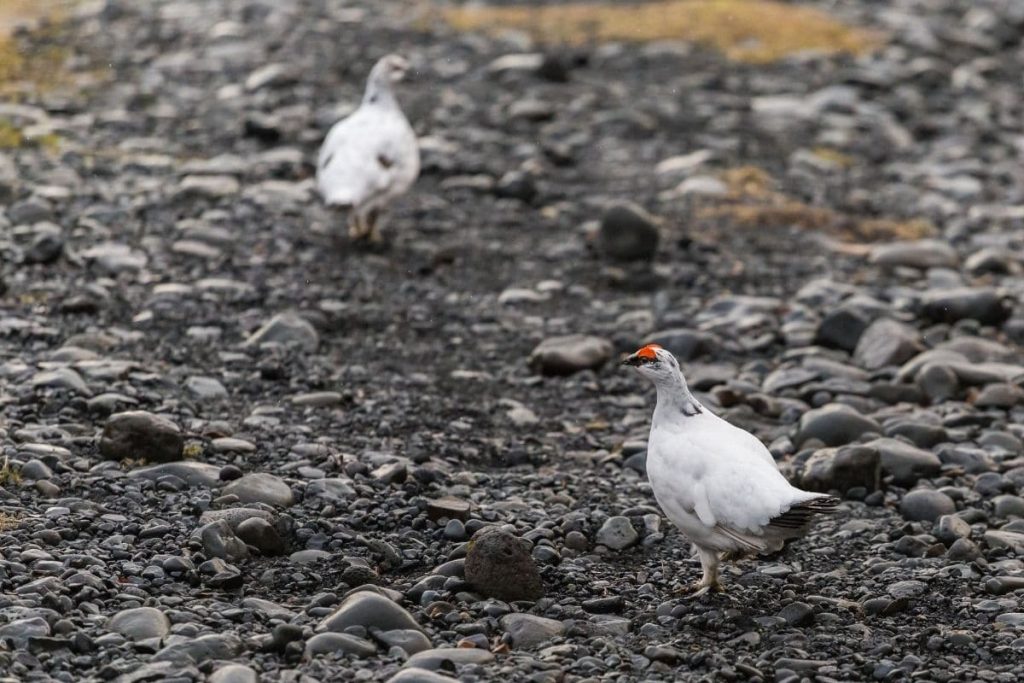
- slightly larger than a partridge, white wings; upper side of the male in mating dress dark, red skin flaps above the eyes; females yellowish brown with dark markings, no red head
- Food: berries, shoots, buds, insects for the young
- Breeding: May to July, one brood, ground nesting between rocks, well camouflaged nest
- Occurrence: richly structured landscapes above the tree line, mainly in the Alps
Bee-eater (Merops apiaster)
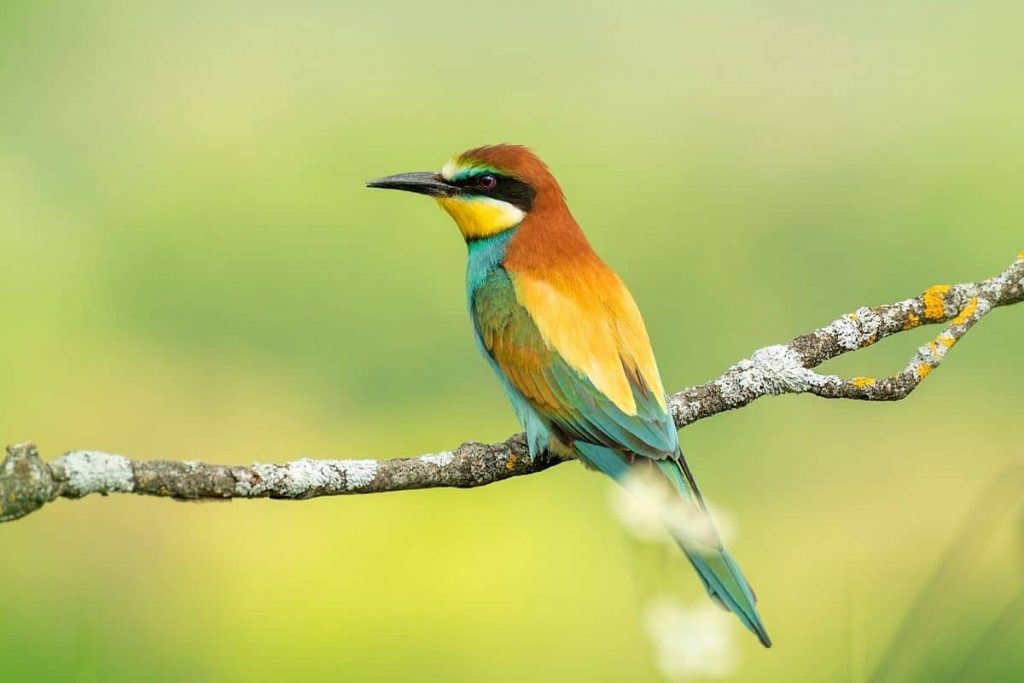
Food: bees, bumblebees, wasps, hornets, but also other larger insects
Breeding: May to July, one brood, nests in steep slopes, builds long tubes with nest chamber at the end
Occurrence: warm areas with varied landscape and steep slopes, breeding bird in southern Europe and rarely in southern Europe
Family: Spinets
Common Redpoll (Carduelis flammea)
Family: Finches

- smaller than a sparrow, plumage brownish or grayish striped, deep red parietal patch; males with reddish breast
- Food: seeds, insects, nuts, suet (at feeders)
- Breeding: May to July, two broods, nest in bushes and trees made of brushwood, moss and stalks
- Occurrence: in coniferous forests, around the tree line, in low mountain ranges, moorlands, alder and willow groves, coniferous woodlands in lowlands
Black Grouse (Tetrao tetrix)
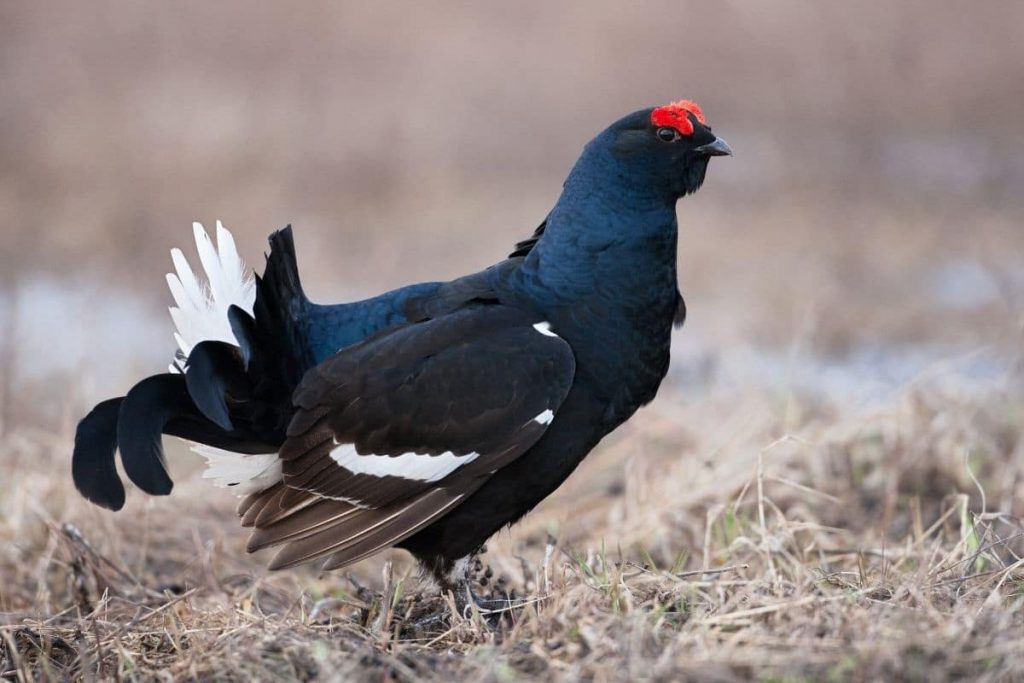
Family: Grouse
- Males blue-black, outward curved tail feathers are fan-shaped for courtship, red unfeathered spots above the eyes; females clearly smaller and with brownish camouflage color, no red head
- Food: buds, shoots, berries, insects
- Breeding: April to June, one brood, ground nesting in dense vegetation
- Occurrence: Bog and heath landscapes, sparse forests, rare.
Blood Linnet (Carduelis cannabina)
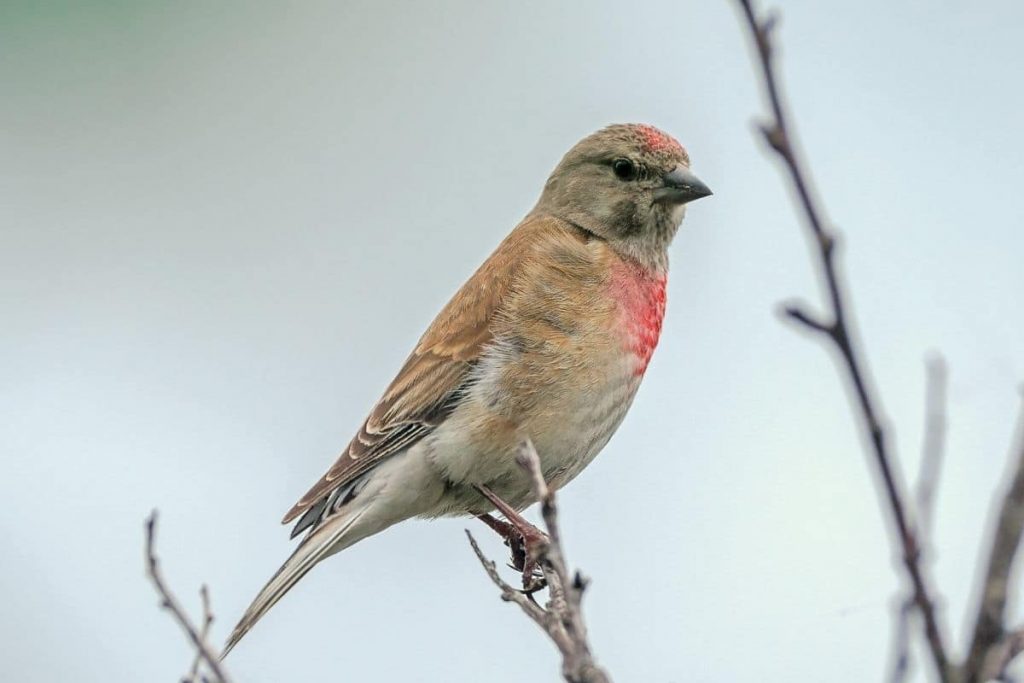
Family: Finches
- Males in mock plumage with conspicuous red crest and red breast, plumage more inconspicuous without red; females brown striped, no red head.
- Food: seeds, insects
- Breeding: April to August, two broods, nests in several pairs at low altitude in bushes and trees
- Occurrence: open cultivated landscapes with hedges and low copses, cemeteries, vineyards, parks and gardens, outside the breeding season in larger flocks, at settlement edges
Pheasant (Phasianus colchicus)
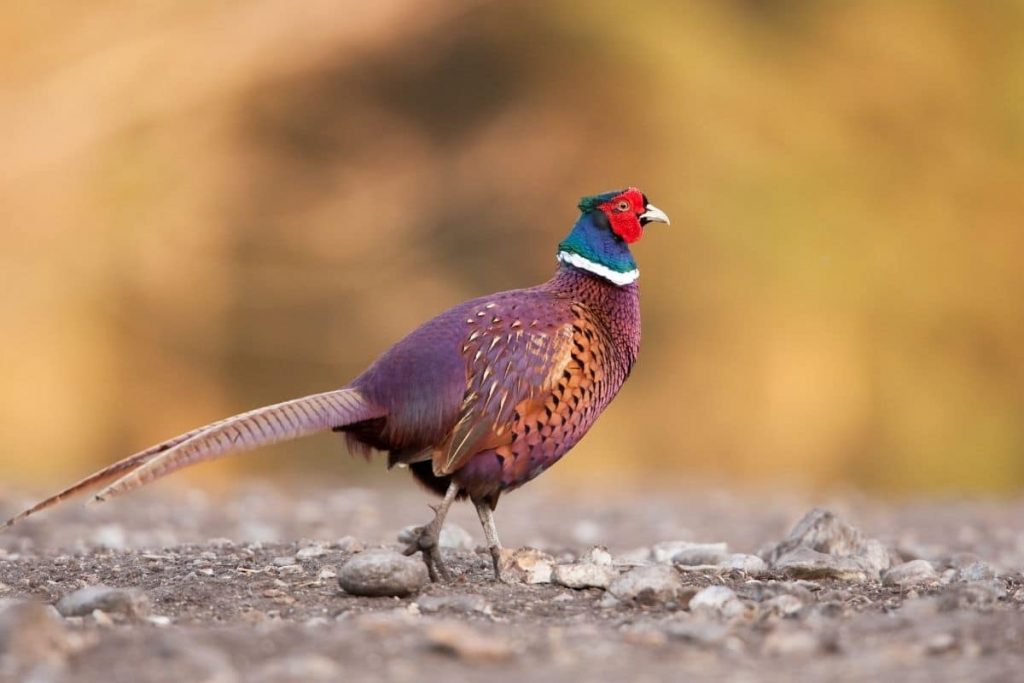
Family: Smooth-legged grouse
- Base color of males and females mottled brown; males with blue-green head, red facial mask especially conspicuous in mating season; females inconspicuous, no red head.
- Food: seeds, grains, fruits, berries, worms, snails, insects
- Breeding: April to June, one brood, ground brood, nest well hidden
- Occurrence: landscapes rich in structures, forest edges, wetlands
- Note: The pheasant originates from Asia and was naturalized in Europe for hunting purposes.
Spruce Crossbill (Loxia curvirostra)

- typical are the crossed beak and the forked tail, males with brick-red markings on the head, ground color rusty brown; females olive green, without red
- Food: spruce seeds, flowers and buds of deciduous trees
- Breeding: year-round, often December to May, one to two broods, breeds in spruce trees, nest made of brushwood, moss and lichen
- Occurrence: Coniferous forest up to tree line
- Family: Finches
Crimson Finch (Carpodacus erythrinus)
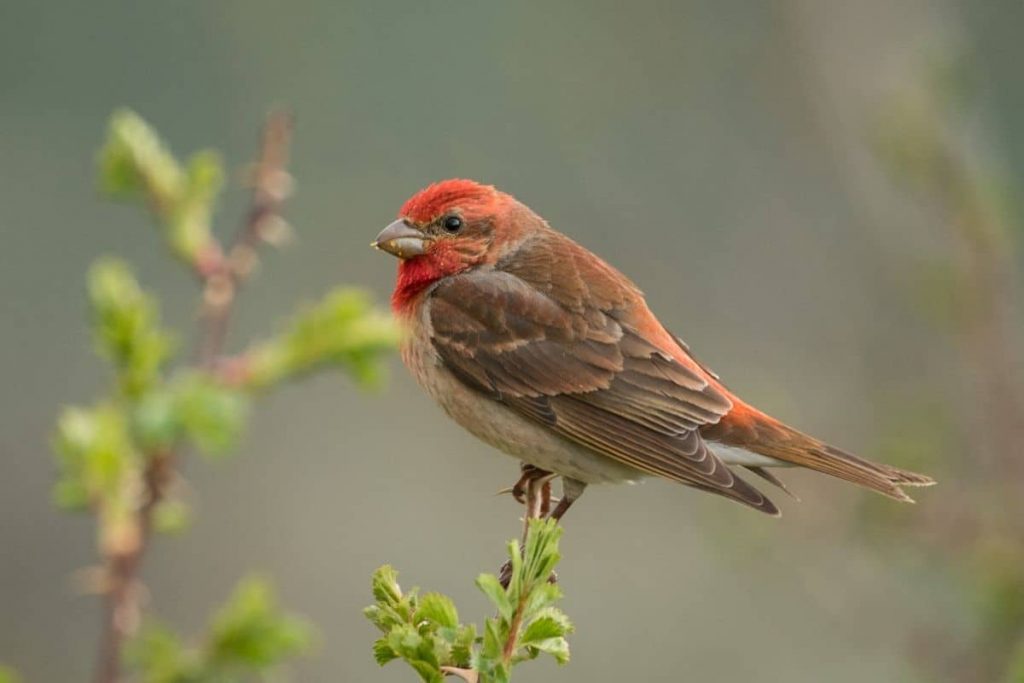
- Males with crimson markings on head, throat and chest, otherwise gray; females brownish, no red head.
- Food: insects, their larvae, buds, shoots, berries and seeds
- Breeding: May to July, one brood, nest at low altitude in bushes or young trees, built of stalks, grasses, fine roots and hairs
- Occurrence: shrub-rich wetlands, willow and alder stands, herb-rich, sparse forests, parks
Barn Swallow (Hirundo rustica)
Family: Swallows

- slender, upper side dark, throat and forehead red, belly white, tail forked
- Food: flying small insects
- Breeding: May to August, two to three broods, nests in buildings, often stables or barns, bowl-shaped nest made of clay and stalks on walls under the ceiling, nests are often reused and therefore must not be removed
- Occurrence: in villages and individual farms, common everywhere, populations nevertheless declining
Robin (Erithacus rubecula)
Family: Thrushes

- small, roundish, orange-red breast and forehead, large, dark eyes, otherwise brownish
- Food: insects, snails, worms, berries, fruits
- Breeding: April to July, two broods, ground nesting in dense vegetation, cup nest made of leaves, grass, moss, also uses cavities near the ground and low nest boxes
- Occurrence: Deciduous and mixed forest with dense undergrowth, parks, gardens.
Woodchat Shrike (Lanius senator)
Family: Shrikes
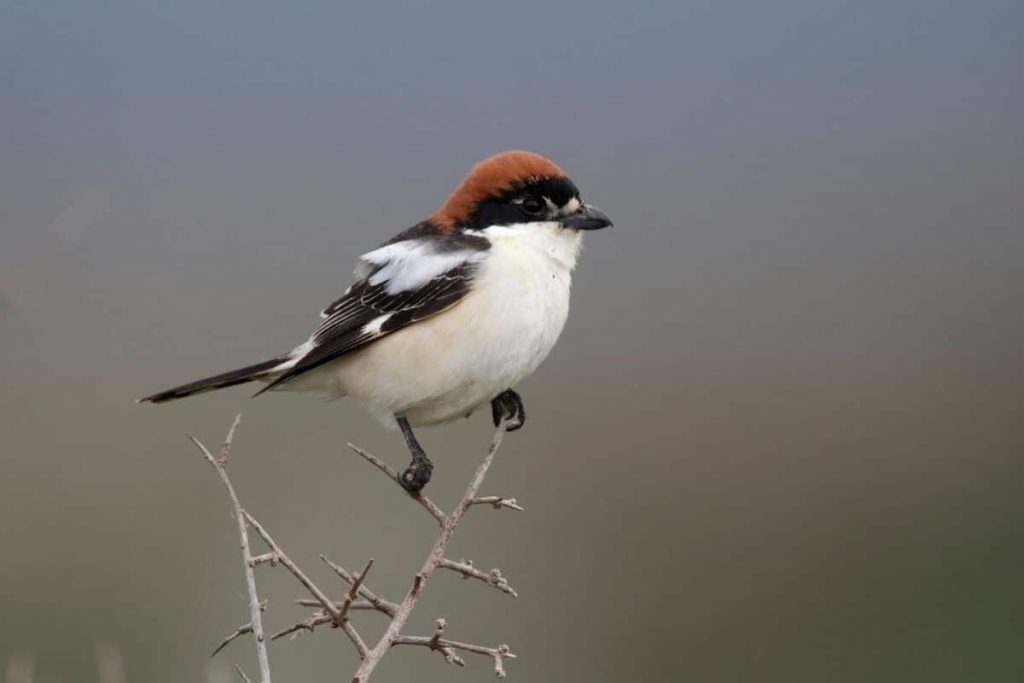
- Top of head brown-red, abdomen and throat white, wings and forehead black; females somewhat paler.
- Food: beetles, bumblebees, other large insects
- Breeding: May to July, one brood, likes to nest in apple or pear trees (meadow orchards), nest made of brushwood, stalks and roots
- Occurrence: open landscapes with suitable breeding trees, mainly southern Europe
Waxwing (Bombycilla garrulus)
Family: Waxwings

- orange-brownish, top of head orange-red, black eye band and wing markings, belly lighter, erect feather cap
- Food: insects during breeding season, otherwise berries of rowan, snowball and hawthorn, fruit
- Breeding: breeds exclusively in northern Scandinavia and northern Russia
- Occurrence: with us wintering guest, very sociable
Family woodpeckers (Picidae)
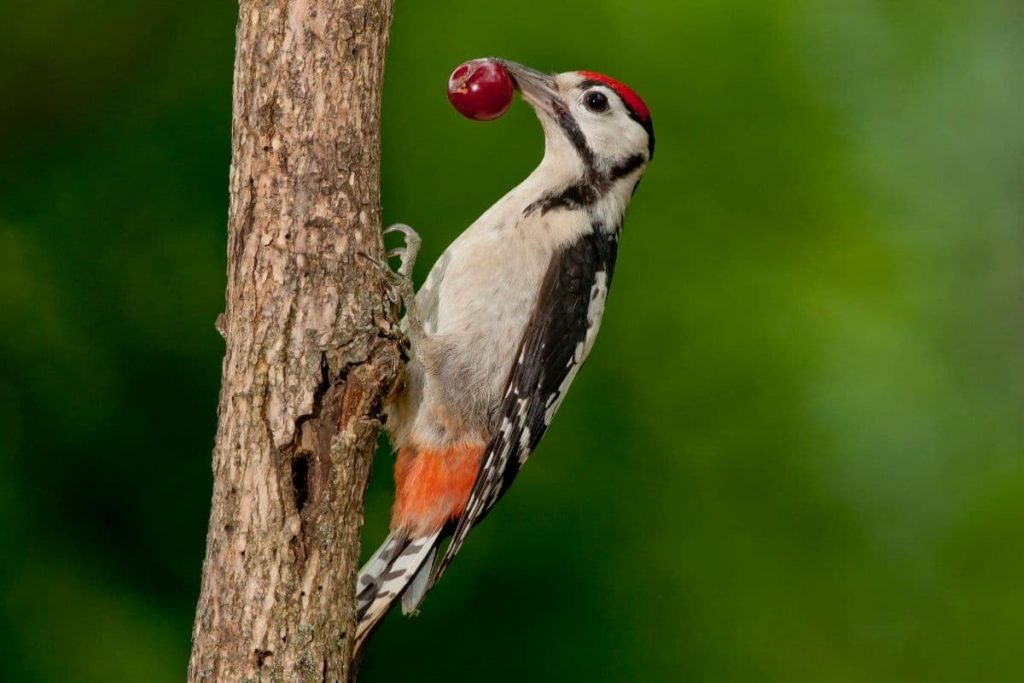
- Gray and Green Woodpecker: ground color green-gray, top of head bright red especially in male green woodpecker
- Black woodpecker: mainly black, red “head plate
- all other native species with red features on the head: plumage black and white spotted or striped, belly often lighter to whitish, under-tail coverts sometimes bright red
- Food: wood-dwelling insects and their larvae, young birds, eggs, fruits, nuts, suet (at feeders), berries, ants and their pupae, snails, worms
- Breeding: March to July, one brood, cavity breeders, carve brood cavities in diseased trees or take over abandoned cavities
- Occurrence: Deciduous and mixed forests, gardens, parks, orchards, cemeteries, mostly old trees needed for breeding
- Species: Gray Woodpecker (P. canus), Green Woodpecker (P. viridis), Black Woodpecker (Dryocopus martius), White-backed Woodpecker (Dendrocopos leucotos), Great Spotted Woodpecker (D. major), Syrian Woodpecker (D. syriacus), Middle Spotted Woodpecker (D. medius), Lesser Spotted Woodpecker (D. minor)
Goldfinch (Carduelis carduelis)
Family: Finches
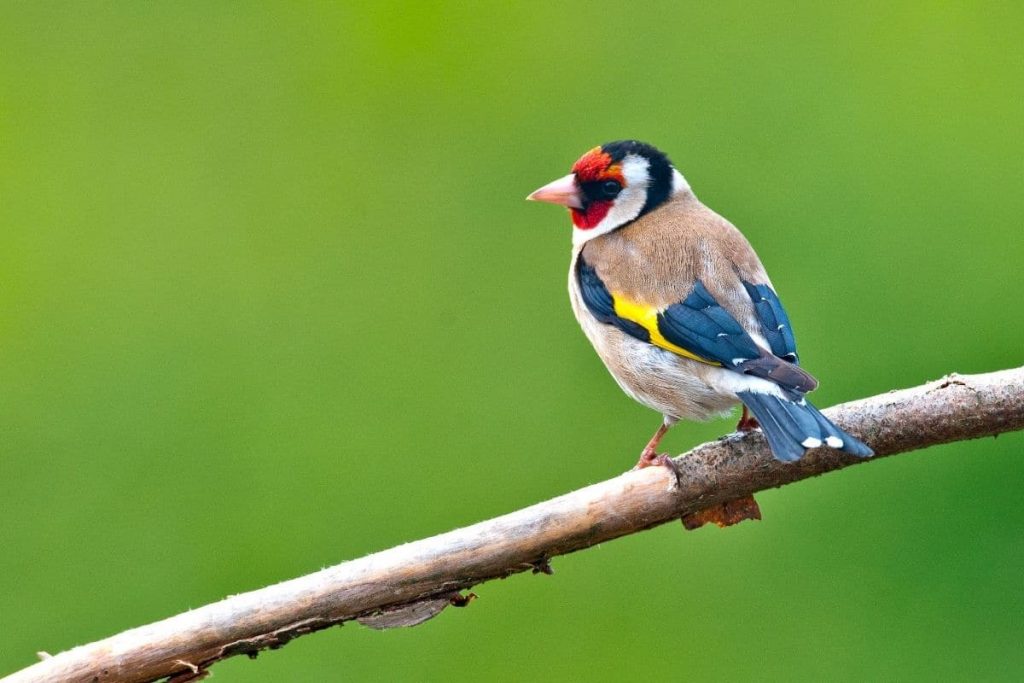
strikingly colorful, with black, yellow, white and red, especially on the head and wings, ground color brown
Food: mainly seeds of thistles, small insects at breeding time and other seeds
Breeding: May to August, two broods, breeds in branch forks of deciduous trees
Occurrence: Parks, orchards, hedgerow landscapes, villages with old trees
Frequently asked questions
When is a garden bird-friendly?
It should be designed mainly close to nature. With many wild plants, trees, brushwood piles, thorn hedges and flowering plants for insects. Then birds will find enough food, hiding places and nesting material.
Can woodpeckers be dangerous to other birds?
They could prey on young birds and eggs. Therefore, nest boxes should always be reinforced with a metal plate around the entrance hole. The woodpecker can then no longer chisel open the nest box.
Which bird species have “roses” on their heads?
These are mainly different species of chickens. The skin flaps are particularly noticeable when they swell during the mating season.


